Special Feature: Products Sally Recommends
Première Bordeaux —Deuxième Jour, Après-Midi
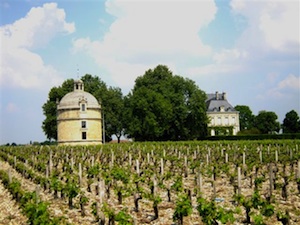 Too nervous to even consider a lunch break, my focus was an on-time arrival at the first-growth vineyard of Chateau Latour. This was one of my earlier contacts, when formulating the itinerary. Yet, it was made more difficult due to my series of miscommunications with Guest Relations Manager, Sonia GUERLOU. The emails that we exchanged seemed to become a chess match, with each player pausing to contemplate the other’s next move before responding. I had mentioned being a wine writer, having experienced my initial rejection from Chateau Margaux as a “regular Joe.” Upon learning my intent, Sonia questioned my proposed article and its content. She even asked about the wines I expected to sample. My ultimate response was I merely wished to write a piece about my own experience on this visit and would be happy with any example of Latour’s great products she allowed me to taste. Then, she started suggesting times for my visit which were not on the days I would be in Bordeaux. I gave her my schedule and asked her to just pick a time, willing to adjust everyone else to her convenience. Thursday afternoon at 2:30 pm. was one of her offerings. Upon chosing it and asking for confirmation, she responded as if annoyed, since I had written her past that evening’s closing time (easy to do from the USA), and the following week was her vacation. The wording of her final email seemed to indicate acceptance, so I decided not to press it further.
Too nervous to even consider a lunch break, my focus was an on-time arrival at the first-growth vineyard of Chateau Latour. This was one of my earlier contacts, when formulating the itinerary. Yet, it was made more difficult due to my series of miscommunications with Guest Relations Manager, Sonia GUERLOU. The emails that we exchanged seemed to become a chess match, with each player pausing to contemplate the other’s next move before responding. I had mentioned being a wine writer, having experienced my initial rejection from Chateau Margaux as a “regular Joe.” Upon learning my intent, Sonia questioned my proposed article and its content. She even asked about the wines I expected to sample. My ultimate response was I merely wished to write a piece about my own experience on this visit and would be happy with any example of Latour’s great products she allowed me to taste. Then, she started suggesting times for my visit which were not on the days I would be in Bordeaux. I gave her my schedule and asked her to just pick a time, willing to adjust everyone else to her convenience. Thursday afternoon at 2:30 pm. was one of her offerings. Upon chosing it and asking for confirmation, she responded as if annoyed, since I had written her past that evening’s closing time (easy to do from the USA), and the following week was her vacation. The wording of her final email seemed to indicate acceptance, so I decided not to press it further.
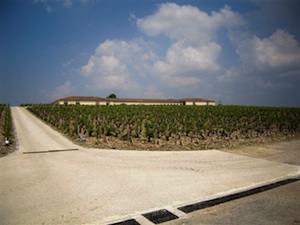 Approaching the facility, I was relieved that my coordinates were accurate, as the GPS directed travel down a roadway which led exclusively to Latour’s estate. Signs for parking were not clear, so I did drive around a bit before discovering that the visitor’s lot was way down in a ravine, presenting a hike uphill to the winery. Possibly that piece of land was determined to be unreliable turf, with respect to planting (since every plant produces at least one bottle of wine at over $1000 each). Walking to the winery building, I was early but did not wish to open the door to the visitor’s area, fearful of sparking the ire of Ms. GUERLOU. Standing outside in the afternoon sunshine, I was motioned to come inside by one of the receptionists. Announcing my appointment time, I took a seat, almost as if awaiting my turn to see the doctor for some painful procedure. Time passed. At ten minutes beyond the appointment, smiling Sonia walked up and introduced herself. I apologized for being the “annoying American” who had caused her so much grief in our communications. She laughed and swore that I had misinterpreted everything. From that moment forward, we became best-buddies. The delay had only been due to another couple’s tardy arrival. The couple never did show-up (unbelievable), so the tour commenced with just the two of us.
Approaching the facility, I was relieved that my coordinates were accurate, as the GPS directed travel down a roadway which led exclusively to Latour’s estate. Signs for parking were not clear, so I did drive around a bit before discovering that the visitor’s lot was way down in a ravine, presenting a hike uphill to the winery. Possibly that piece of land was determined to be unreliable turf, with respect to planting (since every plant produces at least one bottle of wine at over $1000 each). Walking to the winery building, I was early but did not wish to open the door to the visitor’s area, fearful of sparking the ire of Ms. GUERLOU. Standing outside in the afternoon sunshine, I was motioned to come inside by one of the receptionists. Announcing my appointment time, I took a seat, almost as if awaiting my turn to see the doctor for some painful procedure. Time passed. At ten minutes beyond the appointment, smiling Sonia walked up and introduced herself. I apologized for being the “annoying American” who had caused her so much grief in our communications. She laughed and swore that I had misinterpreted everything. From that moment forward, we became best-buddies. The delay had only been due to another couple’s tardy arrival. The couple never did show-up (unbelievable), so the tour commenced with just the two of us.
As we walked to the elevator which descended into the subsurface winery and storage chambers, I asked Sonia about the curious plastic tabs (approximately 1.5” by 5”) attached to all of the vine support wiring I noticed in the vineyards, walking up from the parking lot. They were spaced about two meters apart. Sonia quickly responded, without a blush, that these were “Sexual Confusion.” Swallowing hard, I responded “Pardonnez-moi?” She laughed and explained that it was a part of their evolving process of becoming more biodynamic in the care of their vineyards. For the entire growing season, these tabs emit a hormone into the atmosphere surrounding the vines. This scientifically engineered hormone envelops the harmful insects which fly or crawl into the vineyards, making their systems interpret that it is not the time to generate or fertilize their eggs, thus halting the cycle of procreation. They believe that this has helped to greatly reduce the amounts of pesticides needed to protect the plants.
Sonia was the first to inform me that it was illegal for any vineyards in Bordeaux to be irrigated. My eyes widened as I learned that the Appellations d'Origine Contrôlées (AOC), regulator of all viticulture practices in Bordeaux, has never allowed watering of any grape vines. Moisture must come from the heavens above, or the depths of the rocky limestone “terroir” into which they are planted. To keep vines from being over-watered in times of heavy rainfall, the AOC does allow vineyards to have subsurface “drains” (likely the origin of the term French drain) located approximately one meter deep, between selected rows to channel harmful ponding water away from the root systems. Thus, the cooperation of nature is much more critical here than in many other vineyards around the world. It became more understandable why the great vintages of Bordeaux have been so infrequent.
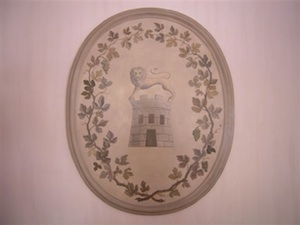 Sonia explained that Chateau Latour was established in 1670 and soon acquired first-growth status alongside Lafite and Margaux. The most notable family name of ownership in its early years was that of Alexandre de Ségur, whose family held the property for three centuries. Its small Chateau building was constructed in 1864 and is maintained as a visiting residence for the current day owner. The succession of ownership continued with shares being passed through a number of private families, negociants and merchants. By 1993, the property was purchased by French billionaire, François Pinault. It became sister holdings with the likes of Gucci, Yves Saint Laurent and Christie’s Auction House. Pinault hired Frederic Engerer to manage the property on an everyday basis. The team has since transformed Latour into the modernized winery that it is today.
Sonia explained that Chateau Latour was established in 1670 and soon acquired first-growth status alongside Lafite and Margaux. The most notable family name of ownership in its early years was that of Alexandre de Ségur, whose family held the property for three centuries. Its small Chateau building was constructed in 1864 and is maintained as a visiting residence for the current day owner. The succession of ownership continued with shares being passed through a number of private families, negociants and merchants. By 1993, the property was purchased by French billionaire, François Pinault. It became sister holdings with the likes of Gucci, Yves Saint Laurent and Christie’s Auction House. Pinault hired Frederic Engerer to manage the property on an everyday basis. The team has since transformed Latour into the modernized winery that it is today.
Latour has 80 hectares planted, 47 of which surround the Chateau. These are the source of the “grand vin,” Chateau Latour (120,000 bottles produced per year). The remaining 33 hectares, along with the inferior grapes from the Latour sorting process, produce the second/third labels of Les Forts de Latour (150,000 bottles per year) and Pauillac de Latour (50,000 bottles per year). The mix of varietals grown is 75% Cabernet Sauvignon, 20% Merlot and the balance split between Petit Verdot and Cabernet Franc.
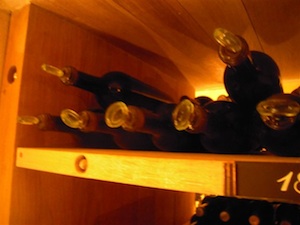 The tour through the underground labyrinth of winemaking equipment, barrel storage chambers, laboratories, bottling and boxing rooms was most impressive. There was elevator access to each of three levels. Considering the immense value of the dirt and the expense of air-conditioning, going down into the ground with less of a footprint made perfect sense. Most impressive were the rooms where old bottles are held and preserved. I saw numerous vintages of Latour, from the early 1800’s and a precious few from the late 1700’s. The older bottles did not have corks, but glass stoppers with large “eyes” for pull-and-twist opening by hand. Each were sealed with a mixture of emery powder and oil. The result, long term, is an adhesion which typically destroys the neck of the bottle if such twisting is attempted. No doubt, preservation of these treasures has been a challenge, especially before our current age of modern technology.
The tour through the underground labyrinth of winemaking equipment, barrel storage chambers, laboratories, bottling and boxing rooms was most impressive. There was elevator access to each of three levels. Considering the immense value of the dirt and the expense of air-conditioning, going down into the ground with less of a footprint made perfect sense. Most impressive were the rooms where old bottles are held and preserved. I saw numerous vintages of Latour, from the early 1800’s and a precious few from the late 1700’s. The older bottles did not have corks, but glass stoppers with large “eyes” for pull-and-twist opening by hand. Each were sealed with a mixture of emery powder and oil. The result, long term, is an adhesion which typically destroys the neck of the bottle if such twisting is attempted. No doubt, preservation of these treasures has been a challenge, especially before our current age of modern technology.
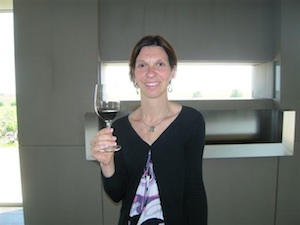 At the conclusion, we surfaced and went into the modern tasting facility, where a bottle of 2006 Latour was opened and awaiting our attention. Sonia pored us full glasses, and we sipped, talking about my adventures so far in the trip. She was aghast when she heard about my rejection by Chateau Margaux. Upon my next return to Bordeaux, she insisted that I contact her when scheduling visits and she would make sure of my acceptance, through a good friend of hers who worked there. Her promise was duly noted.
At the conclusion, we surfaced and went into the modern tasting facility, where a bottle of 2006 Latour was opened and awaiting our attention. Sonia pored us full glasses, and we sipped, talking about my adventures so far in the trip. She was aghast when she heard about my rejection by Chateau Margaux. Upon my next return to Bordeaux, she insisted that I contact her when scheduling visits and she would make sure of my acceptance, through a good friend of hers who worked there. Her promise was duly noted.
The wine that we sampled was way too young for tasting in blissful enjoyment. The tannins had years to go before mellowing into a prize, but the quality of this youngster was evident. It seems a shame that current demand has increased the cost of these single 750 cl. bottles to a dollar amount which would feed entire families for a year in some third world countries. Unless offered by a rich associate, I am sadly destined never to realize such pleasure as tasting a prime vintage of this wine. Yet, this experience was indeed priceless.
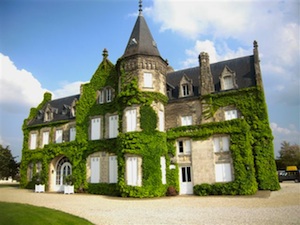 The final visit of the afternoon was back in Margaux at Chateau Lascombes. Lascombes is a second-growth winery which came to my interest quite by accident. About a year ago, my wife asked me to attend a party at one of her client’s houses one afternoon, and I agreed to come along as a good will gesture, not expecting to do more than stand around, looking unimportant, while everyone else chatted away with their friends and associates. Being served out of fancy tilted decanters was a red wine, about which I knew nothing. After sampling it, I had to ask its name and vintage, because it was wonderful. Chateau Lascombes 2004 was the answer. Lascombes would be the first Bordeaux wine I would purchase, after receiving a really nice deal from our local warehouse retailer on two cases of the most highly rated 2005. Unlike many similar functions, she had to drag me away from this place. I made one “good friend” that day.
The final visit of the afternoon was back in Margaux at Chateau Lascombes. Lascombes is a second-growth winery which came to my interest quite by accident. About a year ago, my wife asked me to attend a party at one of her client’s houses one afternoon, and I agreed to come along as a good will gesture, not expecting to do more than stand around, looking unimportant, while everyone else chatted away with their friends and associates. Being served out of fancy tilted decanters was a red wine, about which I knew nothing. After sampling it, I had to ask its name and vintage, because it was wonderful. Chateau Lascombes 2004 was the answer. Lascombes would be the first Bordeaux wine I would purchase, after receiving a really nice deal from our local warehouse retailer on two cases of the most highly rated 2005. Unlike many similar functions, she had to drag me away from this place. I made one “good friend” that day.
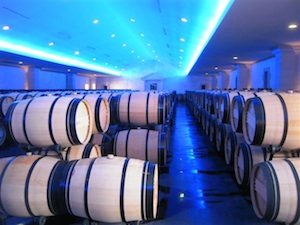 Lascombes was just off of the D-2 roadway, so I felt relatively comforted that my coordinates could not get me into too much trouble. The information was flawless. There were two other Canadian wine journalists on the same appointment with me, both no doubt more skilled than I in analyzing greatness in a young Bordeaux vintage. The tour began in the above ground warehouses where the 2009’s and 2010’s were being stored. Lascombes was the only Bordeaux winery that I visited not utilizing those traditional chestnut wrappings around their barrels. And, atypical for a left-bank property, since 2005 they had abandoned the utilization of Cabernet Sauvignon as the primary grape in each vintage (yielding to Merlot).
Lascombes was just off of the D-2 roadway, so I felt relatively comforted that my coordinates could not get me into too much trouble. The information was flawless. There were two other Canadian wine journalists on the same appointment with me, both no doubt more skilled than I in analyzing greatness in a young Bordeaux vintage. The tour began in the above ground warehouses where the 2009’s and 2010’s were being stored. Lascombes was the only Bordeaux winery that I visited not utilizing those traditional chestnut wrappings around their barrels. And, atypical for a left-bank property, since 2005 they had abandoned the utilization of Cabernet Sauvignon as the primary grape in each vintage (yielding to Merlot).
Several new-age processes were ongoing in this modernized facility. Sorting of grapes was photographically assisted, 32 separate vats were utilized for individual parcels which sophisticated the blending process and dry-ice was utilized to slow the post-picking maceration of grapes before fermentation. Yet, old-world egg-white fining during the barrel racking process remained a practice.
Controlled by a large Medoc family in the 17th century, Dufort de Duras, the property was later divided into what became Lascombes and Chateau Dufort-Vivens (another second-growth vineyard). Ownership of this parcel was inherited by Chevlier Antoine de Lascombes and remained with his descendants for a century. Like so many other Bordeaux properties, it passed from family to family, negociant and business conglomerate. By 2001, an American Pension Fund group landed a 53% stake in the property, hiring Alain Reynaud from another famous Chateau. Reynaud set the winery on its current course for greatness. There are 84 hectares planted, of which 50% are in Cabernet Sauvignon, 45% in Merlot and 5% in Petit Verdot.
 After the tour of the facilities, our host, Anaïs LAFOURCADE, ushered us into the lovely Chateau for our tasting of the new 2010 vintage. Historical chills (yes, I get them) overcame me as I entered. Back in 1976, Jim Barrett (owner of Chateau Montelena in Napa) was having lunch in these very chambers when he received a call with news of his 1973 Chardonnay having won the famed Judgement of Paris wine tasting, changing the California wine industry forever. During World War II, the French Underground utilized Chateau Lascombes as a sanctuary for downed American fighter and bomber pilots while safe passage out of the country was arranged. Later in the war, the Allied Forces used the facility as its French headquarters. The ghosts were all there, loud and clear. I asked Anaïs if she knew exactly where the pilots were hidden. She had no earthly idea, totally unaware of this place’s historical significance (the young ones rarely do anymore). Yet, she offered to ask around before our departure to see if anyone had such a recollection.
After the tour of the facilities, our host, Anaïs LAFOURCADE, ushered us into the lovely Chateau for our tasting of the new 2010 vintage. Historical chills (yes, I get them) overcame me as I entered. Back in 1976, Jim Barrett (owner of Chateau Montelena in Napa) was having lunch in these very chambers when he received a call with news of his 1973 Chardonnay having won the famed Judgement of Paris wine tasting, changing the California wine industry forever. During World War II, the French Underground utilized Chateau Lascombes as a sanctuary for downed American fighter and bomber pilots while safe passage out of the country was arranged. Later in the war, the Allied Forces used the facility as its French headquarters. The ghosts were all there, loud and clear. I asked Anaïs if she knew exactly where the pilots were hidden. She had no earthly idea, totally unaware of this place’s historical significance (the young ones rarely do anymore). Yet, she offered to ask around before our departure to see if anyone had such a recollection.
The tasting was beautifully presented on a large round glass table, cleaned to spotless perfection. I sampled the new 2010 wine and realized that it too needed many years of cellaring before showtime. It was a big wine indeed, and I sensed that it would be considered as one of the better efforts of this decade. Parker’s 2011 springtime notes were not yet released at that point, but when they were published a week or two later, the assessment was confirmed. Other tastes of Chevallier de Lascombes, the second wine, were offered, but I refrained, knowing that I would not likely encounter this puppy again in the USA. The Canadians pounced on the opportunity, further darkening their already extremely purple stained teeth (no doubt they had visited many wineries that day).
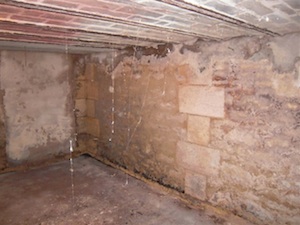 During our tasting, Anaïs disappeared from the room for a consult with the person in charge of the Chateau’s maintenance. She was directed to speak with a very old chamber-maid (fortunately present that day) who had worked there since she was a young girl. Anaïs returned and asked me if I wished to come along as this woman was questioned. The Canadians (previously unaware) were by then intrigued as well. When asked (in French, of course), the old woman nodded, grinned (she remembered) and took us to a closet doorway, rarely accessed. The door creaked open, and as dusty items were removed, an opening appeared to a rough wooden stairway leading down into a basement chamber. We found a light switch, and I led the way, brushing away as many cobwebs as Indiana Jones would encounter in one of his Egyptian crypt explorations. It was just an empty room, about 10 feet square with a 7 feet high ceiling. It was not much to look at, but to some G.I.’s who would later have a second chance to live a full life and prosper back in America, it must have been beautiful.
During our tasting, Anaïs disappeared from the room for a consult with the person in charge of the Chateau’s maintenance. She was directed to speak with a very old chamber-maid (fortunately present that day) who had worked there since she was a young girl. Anaïs returned and asked me if I wished to come along as this woman was questioned. The Canadians (previously unaware) were by then intrigued as well. When asked (in French, of course), the old woman nodded, grinned (she remembered) and took us to a closet doorway, rarely accessed. The door creaked open, and as dusty items were removed, an opening appeared to a rough wooden stairway leading down into a basement chamber. We found a light switch, and I led the way, brushing away as many cobwebs as Indiana Jones would encounter in one of his Egyptian crypt explorations. It was just an empty room, about 10 feet square with a 7 feet high ceiling. It was not much to look at, but to some G.I.’s who would later have a second chance to live a full life and prosper back in America, it must have been beautiful.
With my day concluded, the grounds of the Chateau were combed once again, soaking up the remaining historical sensations. Then it was into the car, with my GPS guiding me back to the hotel. On the way, I stopped in at the Buffalo Grill and feasted on what would be my staple dinner for almost a week. Life was good... The next day, a trip was scheduled into the realm of the Sauternes and then over to the right-bank, where Merlot reigned supreme. The adventures would continue.
Chateau Latour
www.chateau-latour.com
Chateau Lascombes
www.chateau-lascombes.com
Chateau Dufort-Vivens
www.dufort-vivens.fr
Judgement of Paris: California vs. France and the Historic Paris Tasting that Revolutionized Wine by George M. Taber
Buffalo Grill
www.buffalo-grill.fr
Note: This information was accurate when it was published. Please be sure to confirm all rates and details directly with the businesses in question before making your plans.



